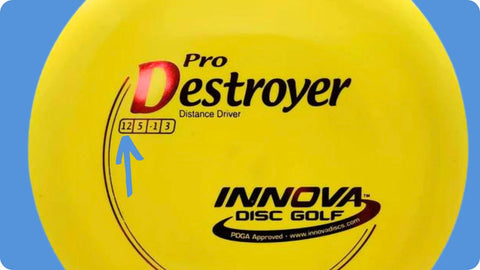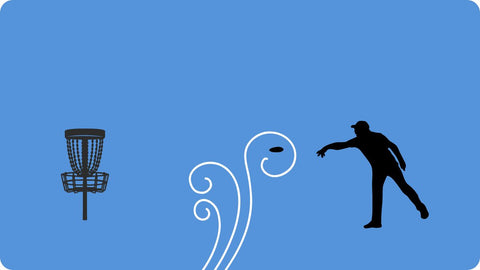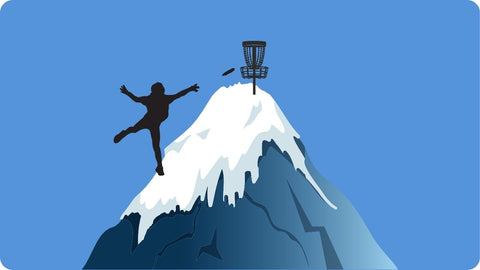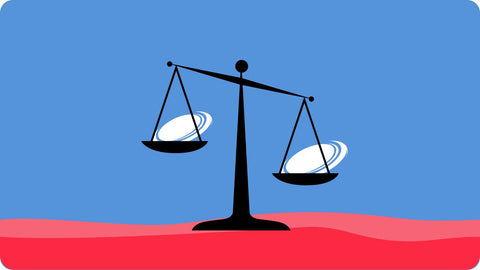Playing disc golf for the first time with your experienced buddies will expose you to a new language. The disc golf language. The two most used and hard-to-understand words in this language are... understable and overstable.
In this article, we'll explain each term and compare them to help you understand by contrast. Then we'll go on to list all the factors that can affect disc stability. If you're ready to improve your disc golf game as a new player read on! This guide will give you the understanding you need to make the crucial adjustments and select the right discs!
Table of Contents
- What Is An Overstable Disc?
- What Is An Understable Disc?
- What Is A Stable Disc?
- Disc Golf Flight Numbers Meaning
- Disc Speed
- Disc Glide
- Disc Turn
- Disc Fade
- How Arm Speed Affects Stability
- How Wind Affects The Stability Of A Disc
- How Elevation Changes Stability
- How Different Plastics Affect Stability
- Does Beating A Disc In Affect Stability?
- Are Heavier Discs More Overstable?
- How Disc Release Angle Affects Stability
- When To Use Overstable Discs
- When To Use Understable Discs
- Common Understable Discs
- Common Overstable Discs
- Frequently Asked Questions About Disc Stability
What Is An Overstable Disc?
To put it simply an overstable disc will move to the left when thrown backhand, and to the right when thrown forehand. This movement is generally referred to as fade by disc golfers. General fade will only take effect at the end of the disc's flight.
Here are some images of overstable backhand and forehand shots.

Most beginners will find that their shots want to fade as soon as they leave the hand. This is due to poor form and a lower arm speed. The number one enemy is throwing the disc nose up.
The Innova Discs Destroyer is quite possibly the most popular overstable disc in the world right now.
What Is An Understable Disc?
Almost the exact opposite of overstable discs, except there is a small catch. Understable discs when thrown correctly will move to the right on a backhand, and to the left on a forehand. This movement is generally called turn. The only difference to fade is that turn will come before fade in a flight path. When a disc turns to the right and then fades back left (backhand) it's called an S shot.
Here are some images of overstable backhand and forehand shots.

Because the turn of understable discs will even out the effect of the fade new players use them to throw straighter shots. Although the actual flight path isn't a straight line the disc will land more in line with where you were aiming.
The Innova Rollo is a new very understable midrange disc. It's a great choice for those who have just started playing disc golf.
What Is A Stable Disc?
A stable disc is basically a disc with a small amount of turn and fade. Do be aware some people use the term stable interchangeably with overstable, just to confuse you a little more.
The truth is a newer player will find an understable disc to fly like a stable disc. More on this later. For now, the main takeaway is that new players should stick to understable discs.
Here are some images of the flight path of the stable Discraft Buzzz, THE most popular disc.

Disc Golf Flight Numbers Meaning
The disc golf flight rating system was developed by Innova a few decades ago. It is the #1 key to understanding how a disc flies without ever throwing it.
Other disc manufacturers have adopted the system since its invention. This means that often the flight numbers are not a perfect representation of a disc's exact flight. Don't worry though they're generally on track, and accurate enough to give a general idea!
The system rates a disc on 4 factors: Speed, Glide, Turn, and Fade. We'll cover each in the next section. If you asked yourself; What do the numbers on a disc golf disc mean? You're in the right place!
Disc Speed

This number is a measure of the speed the disc flys at. It also relates to how fast the disc should be thrown. Throwing a disc faster or slower will affect the other flight numbers. We'll go deeper into that later.
Fast-speed discs are called drivers. You can tell them apart by their wider shallower rims. Although they are secret weapons to massive distance, new players should steer clear until their form develops.
Distance drivers are rated 11-14 speed, and control drivers are rated 9 and 10. Fairway drivers are rated 6-8, with mids generally being 4 and 5. Putters are rated 1-3 speed.
Disc Glide

The second number on the disc is the glide rating. Although glide may not directly affect stability it certainly is related. Discs with less glide have flatter tops, a feature often common to overstable discs. Higher glide means a domed top, which is often the design on more understable discs.
Disc Turn

As covered earlier a turn comes before fade in the flight path. Hence the order in the flight rating system.
Turn is almost always a negative number, the higher the negative number is the more understable the disc. Some discs have a 0 turn rating meaning they won't turn before they fade, and others actually have a positive turn rating (rare). Discs with positive turn will move in the same direction as the fade early on in the flight.
To see the most overstable disc ever made take a look at the Discamania Tilt. Now out of production, it is quite possibly the craziest disc that exists! It has 1 glide, 1 turn, and 6 fade!
Disc Fade

When a disc gets to the end of its flight and begins to lose speed it will start to fade. An early fade is the biggest beginner pain point in the world of disc golf! It's quite likely the reason you're reading this right now!
One of the first steps in disc golf is learning to adjust where you throw based on the fade. When you throw a frisbee you would generally aim straight at what you're throwing to. With a disc you should aim to the side and let the fade pull it back to the target.
This is all very well, but what happens when you're in the woods and don't have the space? Or the course you're playing demands a differently-shaped shot. This is why we need to have a mix of overstable, understable, and stable discs in our bags.
How Arm Speed Affects Stability

So one day you went onto the internet a bought yourself a Buzzz. You understand the flight numbers and if they are correct this disc should fly straight right? To your surprise, you find that it fades nearly as much as everything else you've thrown! So were the disc golf numbers wrong? Nope, you were.
Okay, maybe that's a little harsh. The fact is that if a disc is not thrown at the correct speed, the turn and fade will act differently. Throwing the disc slower will increase the fade. Throwing it with too much power will increase the turn.
This isn't necessarily a bad thing. This way you can get different flights out of the same disc! When you're a beginner we recommend you start out throwing understable putters. Yes, you can throw putters! Pros do it all the time.
Using slower discs like putters, to begin with, helps you to perfect your form. You'll also find you'll be throwing as far with putters as you do with distance drivers. This is because you should start getting an S flight rather than an early fade. The S curve is the golden ticket to easy distance. Besides this, you'll have much better control and accuracy with slower-speed discs!
How Wind Affects The Stability Of A Disc

Your first windy round probably came as a shock to you. You step up to the tee and feel the breeze blowing into your face. You pull your favorite driver out of the bag and start your run-up. For some reason instead of the pleasing S flight you normally get your driver inexplicably turns and burns into the ground! Welcome to headwinds!
Headwinds

When you're throwing your disc straight into the wind, it's a headwind. The majority of discers consider these the worst because they take away distance and cause your disc to turn over!
Another common result is having your disc pushed up high into the sky. It then comes straight back at you sometimes landing behind where you threw from. Don't ask how I know! This is the result of throwing nose up into a headwind. The wind gets under the flight plate, much like a sail
The key takeaway here is that you may want to change up to a more overstable disc when throwing into a headwind. You should also make it a key focus to keep your shot nose down. There's a ton of content out there on keeping your shots nose down. It's worth looking into because it's the #1 noob mistake!
Tail Winds

Yep, we all love tailwinds. These move in the same direction as your shot, resulting in extra distance!
Just watch out, tailwinds can add fade to your shot. (make your disc more overstable) It may be worth changing up to a more understable disc. Also, be careful you don't overshoot your target and end up in OB!
Cross Winds

Crosswinds push your disc from left to right, or right to left. If the crosswind is strong you may need to adjust your shot for it! If the wind blows your shot to the left you need to aim a little more to the right.
There is one nuance. The disc angle. Once again the wind blows your disc like a sail if it gets underneath it. Just one more thing to assess before taking your shot!
If you don't understand disc angle take a look further down at the brief explanations of hyzer and anhyzer.
How Elevation Changes Stability

This is crazy but true! Your altitude above sea level changes how your disc will fly!
If you're higher above sea level your disc will be more overstable. This is because air pressure decreases. If you're closer to sea level your disc will turn more (understable).
Unless you travel and disc golf a lot this won't be a problem for you. You'll be playing courses at very similar altitudes.
The key takeaway here is that if you plan to hike up Mt. Everest to toss a disc, pack something understable! The last thing you want is to get all the way up there and throw a bad shot!
P.S. The Mt. Everest shot would make a cool YouTube video! Anyone keen?
How Different Plastics Affect Stability

Don't worry, you don't have bad eyes. Here we have the same mold with different disc golf numbers. Why, because of the plastic. Premium plastics tend to be more overstable.
Low grade - Most understable, often lighter, and beat in easier which contributes to this.
e.g. Innova DX
Premium grade - Overstable, generally in heavier weights with slower wear times.
e.g. Innova Star and Champion. Translucent plastics like Champion are generally the more overstable of the 2.
Glow - Premium glow discs tend to be the most overstable versions of a mold.
e.g. MVP's Eclipse glow plastic
Does Beating A Disc In Affect Stability?

Yes, beating a disc in does considerably affect its flight! When a disc starts to wear it almost always becomes more understable. Some players love buying used discs for this very reason!
As crazy as this sounds many disc golfers have spent a lot of time throwing their discs into a brick wall. Literally. It seems ridiculous but this can help you achieve the optimal flight path.
A common practice with the pros is disc cycling. This is when a player has multiple discs in the same mold. For instance, Paul McBeth might have 5 ESP Forces. Each one is in a different stage of wear giving a slightly different flight. Back in his old Innova days, he used to carry 4 McPro Roc3s. He enjoyed the softer McPro plastic because it was easier to beat it in.
Are Heavier Discs More Overstable?

Yes, a heavier disc is more overstable, whereas a light disc is more understable. If you're a beginner starting with lighter discs is a great idea! Not only are they more understable, but they also fly further. The only drawback is that they don't do well on windy days.
What is a light disc?
A light disc weighs between 130 and 165 grams. You can sometimes get lighter than that but it's rare. Look for plastics with mico bubbles like Innova's Blizzard plastic. This is a premium-grade disc with small bubbles in the plastic to reduce the weight.
P.S. The Innova Blizzard Boss currently holds the world record for the longest throw in disc golf! David Wiggins Jr. threw it 1108 feet!
What is a medium-weight disc?
The medium weight range for discs is roughly 160 - 170 grams. These are a great choice if you want a specific disc with a little extra turn.
What is a heavy disc?
Heavy discs range from 170 to 180 grams. Discs heavier than 180 grams are not in line with PDGA standards and cannot be used in their tournaments. This weight range is the most overstable. Discs in this range also make great wind fighters!
How Disc Release Angle Affects Stability
Now comes a curveball about disc golf flight numbers. The numbers on a disc are only accurate when you throw the disc with a flat release. There are three distinct angles to throw with and we'll cover each one in this section.
Flat Release

This is simply releasing the disc at a 180-degree angle. When released like this discs will fly the closest to their flight numbers. Being able to throw a disc flat is something of skill and is worth practicing.
Hyzer Release

To throw a hyzer simply tilt your disc counterclockwise. Or clockwise if you throw forehands or you're left-handed. A hyzer angle will make the disc more overstable.
A unique and useful shot called the hyzer flip is achieved by throwing an understable disc on a hyzer angle. The disc will turn and flip up to flat, allowing for the straightest shots possible in disc golf
P.S. Kevin Jones bags a lot of understable discs because he loves throwing with a hyzer release angle. See Kevin Jones' bag here.
Anhyzer Release

Anhyzer is simply the direct opposite of hyzer. Tilt your disc clockwise (right-hand backhand shots) at release. This will make the disc turnover more.
Throwing an overstable disc on anny produces a flex shot. The disc turns due to the angle, and then fights out and fades because of its overstability. If you want to throw a roller just release an understable disc on anhyzer.
[why-dgd-widget]
Conclusion To Understable vs Overstable
Hopefully, this guide gave you a thorough understanding of the differences between overstable and understable discs. If not we sincerely apologize for wasting 10 minutes of your time! To help summarize this rather lengthy article we've included some lists below as key takeaways.
By the way: The color of a disc can affect stability too!
When To Use Overstable Discs
- When you're more advanced
- When shot shape you need to throw requires to fade.
- In the wind.
- For forehands.
- For flex shots.
When To Use Understable Discs
- As a beginner understable discs will fly further and straighter.
- When the shot shape requires a turn and fade.
- For tailwinds.
- For forehands as a beginner.
- For hyzer flips when you need to throw a straight shot. (tunnel shot)
- For rollers. Useful when low ceilings are present or for long distances.
Common Understable Discs
Common Overstable Discs
Frequently Asked Questions About Disc Stability
Does weight affect the stability of a disc?
Yes, a heavier disc is more overstable while a lighter disc is more understable.
What is an understable disc?
An understable disc has more turn than fade.
What is an overstable disc?
An overstable disc has more fade than turn.
Does elevation affect disc stability?
Yes, the higher up you go from sea level.
Does beating a disc in make it more understable?
Yes almost always. When a disc is more worn it becomes more understable, although in some rare cases, it can become more overstable.
What is hyzer in disc golf?
Hyzer is when you release the disc golf disc with a counterclockwise angle pointing to the ground. (For right-hand backhand shots.)
What is anhyzer in disc golf?
Anhyzer is when you release the disc with a clockwise angle tilted toward the sky. (For right-hand backhand shots.)
What is fade in disc golf?
Fade happens at the end of a disc golf disc's flight. When you throw a backhand the disc fades left, and when you throw a forehand it fades right. Note that you must switch those around if you're left-handed.
What is turn in disc golf?
Turn happens before a disc fades. A disc will turn right on a backhand drive and then fade back left. Note that is reversed for left-handed players.
Does the plastic of a disc affect its flight?
Yes, the plastic does affect a disc's flight. Premium plastics are more overstable, and lower-grade plastics are more understable.






































































































































































































































































This was a really good article. Very informative and concise. I came away with a better understanding about more terms and disc function than I was searching for. Thanks!!!